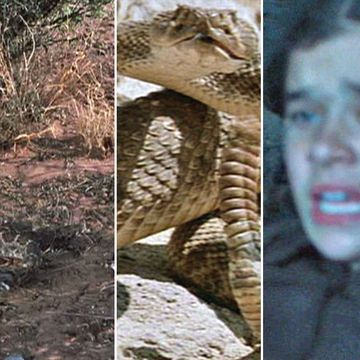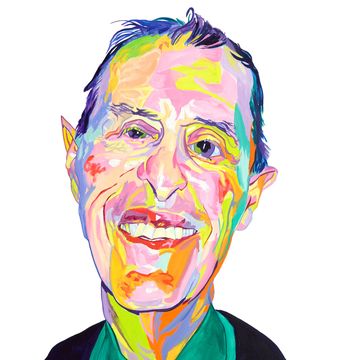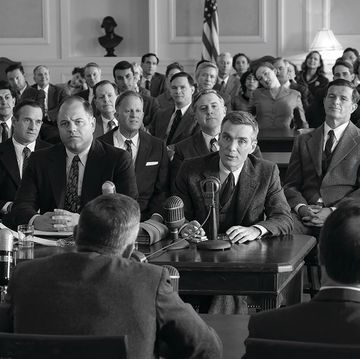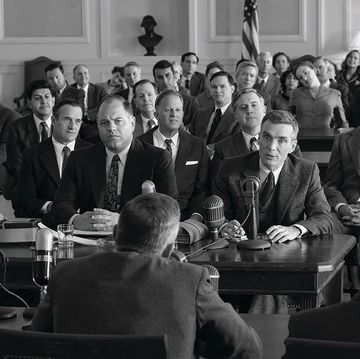If you’ve never wandered west of the mighty Mississippi, set nary a foot left of the Rockies, motored not one mile of Route 66 from Chicago to Santa Monica—and don’t forget Winona—your image and understanding of the West was likely hewn from that most iconic form of American visual arts, the western. You might argue, as do the French, that the gangster film, or perhaps even film noir, is the more American genre. Aren’t we a nation of too many guns and shadowy violence? But that’s a bit limiting; nothing more than the western has incorporated so many of the rituals and beliefs that have formed the backbone of this country. During the 1950s, westerns were produced in greater numbers than all other genres combined.
This article appears in Issue 29 of Alta Journal.
SUBSCRIBE
Here is the story of America in the later part of the 19th century, those movies said. Here’s what we did as citizens and settlers…to the land…to the Indians…to build the railroads…to create some sense of law and order…to women. They were not just offering a set of binoculars, or a magnifying glass, to gaze at and home in on all those memorable images of vast landscapes framing an individual whose sole purpose, in that moment, was to overcome a set of almost insurmountable odds: towering mountains, stampeding cattle, nasty outlaws (who’d hang you), no water, a howling snowstorm.
Westerns were also holding up a mirror—and asking a question: How does this look to you? What do you think? A half century ago, when I asked John Ford, the director who almost single-handedly put the genre on the map, what he was trying to communicate in all those stories he set among the sandstone buttes in the magnificently hued Monument Valley, he simply held up the mirror…to me. In a gruff tone—Ford almost always seemed to be gruff—he replied, “Whatever you see in them.”
What I had seen, at least initially, came in 35-cent Saturday matinees during the 1950s at the Lyceum Theatre in Bayonne, New Jersey, which played scratchy old 16-millimeter prints of Roy Rogers westerns as the warm-up for whatever was current. Never mind that Rogers had an NBC show by then; we didn’t have a TV, and my father, who had done some silent-film accompaniment as a high school violinist, thought children belonged in a movie theater, not in front of a boob tube. Rogers was not a cowboy who’d ever have fit into a Ford western. He was too straitlaced and sunny. But he did very much represent the good guy in the white hat. And he sang, perhaps best known for Dale Evans and his “Happy trails to you, until we meet again / Happy trails to you, keep smilin’ until then…”
However sanitized, Rogers had been a very consistent and very successful part of the classic western era, which established many of the iconic tropes associated with the genre. The hero generally stood in stark contrast to the villain(s), frequently depicted as outlaws, corrupt businessmen, or…Indians, “savages” in the parlance of the medium and the times. The simplistic moral dichotomy reflected a pre-Vietnam American ethos, in which good and evil were seen in clear-cut terms. College students didn’t march on Washington after Pearl Harbor; they enlisted! There’s probably no film that better presents an idealized vision of the American West—rugged individualism, manifest destiny, the triumph of civilization over wilderness—than Ford’s own Stagecoach (1939). The film’s dolly shot pushing into a rifle-twirling John Wayne turned him into a huge star. The melting-pot collection of travelers in the stagecoach of the title—the hooker with a heart of gold, the drunk doctor, the crooked banker, the romantic gambler—are ambushed, only to be rescued by Wayne’s Ringo Kid, himself on the lam as an (unjustly) accused murderer. For Ford, the Kid embodied the ideal of a strong, morally upright individual: a stoic, self-reliant man (always men) of few words but decisive action who brought order to a chaotic frontier. As Walker Percy observed in his novel The Moviegoer (1961), whose protagonist lives to watch stories unfold on a big screen, “Other people, so I have read, treasure memorable moments in their lives.… What I remember is the time John Wayne killed three men with a carbine as he was falling to the dusty street in Stagecoach.”
There were certainly other directors plying their trade in the classic western genre in this time frame. Howard Hawks, also with Wayne, made Red River (1948) and Rio Bravo (1959), with Dean Martin as a deputy coming off a long drunk. Budd Boetticher created an extraordinary series of seven films starring Randolph Scott, always as the odd man out. Raoul Walsh featured a not-yet-star-power Wayne in The Big Trail (1930), a production so massive it almost bankrupted the film company Fox; he was also behind Pursued (1947), perhaps the darkest western ever made, with Robert Mitchum trying to make sense of a hazy past. There was also Anthony Mann, who directed James Stewart in several films, including Winchester ’73 (1950), a sort of biopic about a rifle, and The Naked Spur (1953), with Stewart more neurotic than he would be in Vertigo (1958), chasing an outlaw to haul him back to justice. And, of course, Sam Peckinpah, whose almost perfect Ride the High Country (1962) is an homage to aging gunslingers (played by Scott and Joel McCrea). Along with Ford, Peckinpah would help usher in the era of revisionist westerns a few years later.
THE CLASSICS
All of these classic westerns—how cinema used to reckon with the West—implicitly or explicitly embraced the concept of manifest destiny, the 19th-century belief that American expansion across the continent was god-given (by a Christian god, of course), justified, and inevitable. Films often presented the taming of the wilderness and the establishment of law and order as inherently positive developments. This narrative frequently came at the expense of Indigenous perspectives. Native peoples were often portrayed, with little nuance or historical accuracy, as obstacles to progress or as noble savages. Films like Ford’s The Searchers (1956) exemplified the problematic depiction of Native people in this era. “They ain’t white, not anymore,” Wayne’s character, Ethan Edwards, says of some women who have been captured by a local tribe. “They’re Comanche.” The implication was clear: sex with anyone not white transported you to the dark side.
Classic westerns typically adhered to traditional gender roles. Women were almost always relegated to supporting characters, playing schoolteachers, saloon girls, or wives waiting to stand by their men when they returned from adventure. Central characters such as Barbara Stanwyck’s tough-as-nails cattle rancher in Forty Guns (1957) were rare departures from the norm. The arrival of new technologies, particularly the railroad, was a common theme in classic westerns. Films as early as Ford’s The Iron Horse (1924) celebrated technological progress as a civilizing force. The contrast between the old ways (horses and stagecoaches) and the new (trains and telegraphs) often served as a sanitized metaphor for the broader changes sweeping through the West.
The establishment of law and order in frontier towns was another recurring theme. Sheriffs and marshals stood bravely against chaos and criminality. Ford’s My Darling Clementine (1946) romanticized the historical figure Wyatt Earp, turning him into a larger-than-life symbol of justice. This focus on law enforcement often glossed over the more complex realities of frontier justice and the sometimes blurred lines between lawmen and outlaws.
THE REVISIONISTS
As societal attitudes shifted in the 1960s and 1970s, a new wave of western films emerged that sought to challenge and deconstruct the romanticized myths perpetuated by classic westerns. These revisionist westerns offered a more critical, more nuanced, and often darker view of the American West, reflecting the changing cultural and political landscape. Not surprisingly, it was Ford who opened the way for revisionist westerns, with The Man Who Shot Liberty Valance (1962), a twisting story filled with ambiguity around who actually fires the kill shot that stops Lee Marvin’s titular character. Early in the film, Valance savagely beats Ransom Stoddard, a frontier lawyer played by Jimmy Stewart, in a scene marked by a level of violence never seen in Ford’s earlier work. “I’ll teach you law,” Marvin says. “Western law.” And down comes the whip. While straddling the line between the classic and revisionist periods, Liberty Valance examined the role of mythmaking in the West, delivering a line so memorable that it has become a cliché: “This is the West, sir. When the legend becomes fact, print the legend.”
Revisionist westerns blurred moral lines more readily than earlier films. The clear-cut distinction between heroes and villains gave way to more complex, flawed characters. Films like Peckinpah’s The Wild Bunch (1969) presented violent, morally ambiguous outlaws as their protagonists, challenging the notion of the noble western hero. This shift mirrored the growing disillusionment in American society, influenced by such events as the Vietnam War and the Watergate scandal. The idealized western hero was replaced by antiheroes and morally compromised individuals, indicative of a more cynical view of American exceptionalism. Revisionist westerns often depicted violence in a more graphic and realistic manner, forcing audiences to confront its consequences.
Certainly, the increased realism of the genre extended to other aspects of frontier life. Films began to offer more honest portrayals of Indigenous people. Movies like Arthur Penn’s Little Big Man (1970) critically examined the U.S. government’s treatment of Natives. These films often inverted the traditional narrative, showing Indigenous people as victims of white aggression rather than obstacles to progress. This change reflected the civil rights movements and a growing awareness of historical injustices. Revisionist westerns also frequently deconstructed traditional narratives sustained by earlier films. McCabe & Mrs. Miller (1971), by Robert Altman, presented a gritty, unglamorous view of survival in the Old West. The film’s muddy, rainy setting was a far cry from the sunbaked vistas of classic westerns. Being a prostitute hardly seemed romantic. Michael Cimino’s Heaven’s Gate (1980) offered a scathing depiction of class warfare and the power of wealthy cattle barons over poor immigrants. Revisionist westerns often dealt with the closing of the frontier and the end of the Old West. Don Siegel’s The Shootist (1976), Wayne’s final film, portrayed an aging gunfighter in the early 20th century, out of place in a changing world. This theme of the dying Old West served as a metaphor for the passing of an era and the loss of a certain American identity.
THE CONTEMPORARIES
The revisionist western era set the stage for the even more diverse approaches to the genre that would emerge in contemporary western filmmaking. It’s tough to pin down an exact point for this transition, but Ridley Scott’s Thelma & Louise (1991) is a good guess: arguably a road-buddy movie, it was a blending of tropes that would characterize this latest iteration of the western. The Coen brothers’ No Country for Old Men (2007) and David Mackenzie’s Hell or High Water (2016) borrowed elements from crime thrillers, while Jon Favreau’s Cowboys & Aliens (2011), a clever idea that just didn’t work, merged western tropes with science fiction. This hybridization has allowed filmmakers to explore western themes in new contexts, keeping the genre fresh and relevant. Ang Lee’s Brokeback Mountain (2005) explored gay love in a western setting, challenging the genre’s traditional notions of manhood. This theme recurred even more darkly in Jane Campion’s Power of the Dog (2021), wherein Benedict Cumberbatch’s domineering rancher is undone by a stepson he considers lacking in masculinity. Women’s roles in westerns have expanded significantly. Kelly Reichardt’s extraordinary Meek’s Cutoff (2010) centered female protagonists, offering new perspectives on frontier life and challenging the male-dominated narratives of earlier westerns, while her First Cow (2020) presented a compelling tale of friendship between a Jewish cook and a Chinese drifter who dream of a better life based on baked goods crafted with…purloined ingredients.
Andrew Dominik’s The Assassination of Jesse James by the Coward Robert Ford (2007) delved into the psychology of western legends, demythologizing them while also exploring the nature of celebrity in the Old West. Chloé Zhao’s The Rider (2018) depicted a rodeo star who’s paralyzed by an accident and has to find a new life. (Clint Eastwood’s 1992 Unforgiven, while straddling the line between revisionist and contemporary, offered a similar deconstruction of western violence and heroism.) Jacques Audiard’s The Sisters Brothers (2018) subverted many tropes, presenting a more humane and introspective take on the genre while still maintaining its western identity.
Contemporary westerns also frequently engage with environmental themes, reflecting growing concerns about climate change and resource management. Eastwood’s Pale Rider (1985), while slightly earlier, set a precedent by focusing on the environmental damage caused by mining. More recent films, like Taylor Sheridan’s Wind River (2017), have touched on issues of land use, resource extraction, and the economic challenges facing rural communities in the modern West.
THE FUTURE
Just as I had been exposed to westerns as a kid, I wanted to provide the same for my son—unlike me, a native westerner, a Californian—and fed him a steady diet of horse operas until he was old enough to experience the real thing. And so from time to time, we ventured out to movie locations: Boothill Graveyard in Tombstone, Arizona, where John Sturges had set Burt Lancaster and Kirk Douglas in his Gunfight at the O.K. Corral (1957); Little Bighorn Battlefield near Hardin, Montana, the site of Custer’s last stand, which Ford had mythologized in Fort Apache (1948); and ultimately, the View Hotel in glorious Monument Valley, Arizona, not far from Goulding’s Lodge, where Ford had stayed when filming there. The hotel had set up a screen in its courtyard and was playing a VHS copy of Ford’s She Wore a Yellow Ribbon (1949), in which Wayne’s Captain Nathan Brittles is charged with mollifying relations with the Cheyenne and the Arapaho after Custer’s bloody rampage. It seemed appropriate that the hotel, built in 2008, was owned by the Navajo Nation. Harry Goulding, an Indian trader, had extracted a square mile of the nearby valley—former Navajo land—for $320 from the state of Utah in 1921. The Navajo Nation bought it back in 2023 for $59.5 million. Not surprisingly, Ford never depicted traders in a positive light.
On that visit, while looking out at the Mittens—the sandstone buttes immortalized by Ford, which indeed look just like fingerless gloves, and which the Navajo believe are the carcasses of long-defeated monsters—I reflected on the evolution of the western and its impact on our collective imagination. The West, as both a place and a concept, had always been a canvas onto which we projected our deepest hopes, fears, and contradictions. And as the last light faded and the stars began to emerge so brilliantly, I realized that the story of the West was far from over. It was a living, breathing tale, constantly evolving with each new generation. As long as there were storytellers willing to hold up that mirror, to question and to reimagine, the trails would never truly end. Happy trails, indeed.•
Tom Zito is a serial entrepreneur. He came to California to report a piece on startups for the New Yorker, but launched a company instead. In addition to the New Yorker, he has written for the Washington Post, Esquire, Rolling Stone, Playboy, Cosmopolitan, Life, Newsweek, and many other publications, and has started eight companies.



















